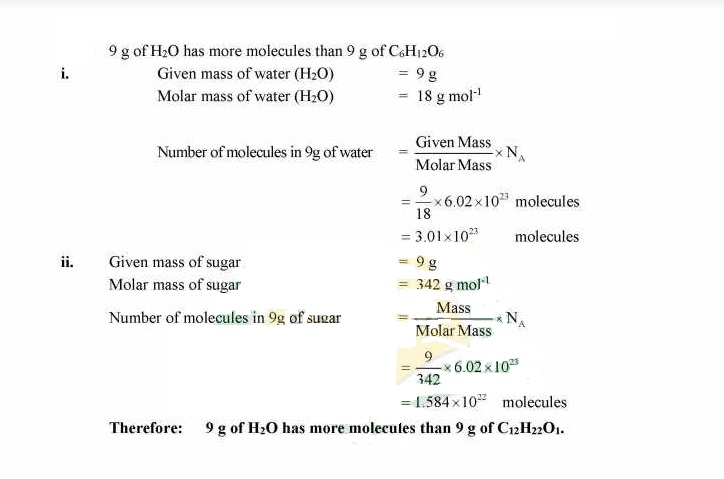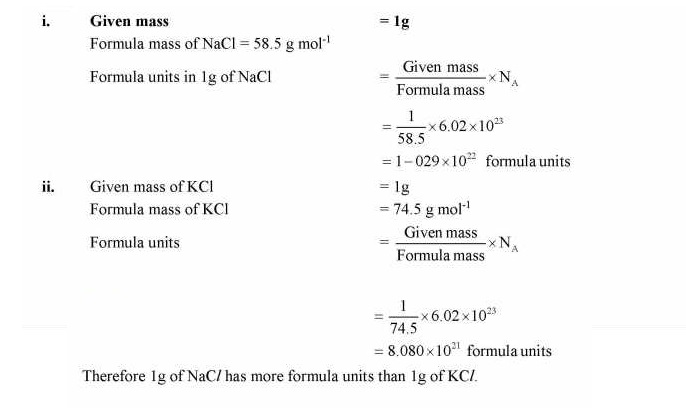Unit 1 – Fundamentals of Chemistry (Short Questions)
Q.1 Define industrial chemistry and analytical chemistry.
Q.2 How can you differentiate between organic and inorganic chemistry?
Q.3 Give the scope of biochemistry.
Q.4 Wow does homogeneous mixture differ from heterogeneous mixture?
Q.5 What is the relative atomic mass? How it is related to gram?
Q.6 Define empirical formula with example.
Q.7 State three reason why do you think air is a mixture and water is a compound?
Q.8 Explain why are hydrogen and oxygen considered elements whereas water as a compound.
Q.9 What is the significance of the symbol of an element?
Q.10 State the reasons: soft drink is a mixture and water is a compound.
Q.11 Classify the following into element, compound and mixture:
Q.12 Define atomic mass unit. Why is it needed?
Q.13 State the nature and name of the substance formed by combining the following:
Q.14 Differentiate between molecular mass and formula mass, which of the following will be molecular formula?
Q.15 Which has more then atoms: 10 g of Al or 10 g of Fe?
Q.16 Which one has more molecules: 9 g of water or 9 g of sugar (C12H22011)?
Q.17 Which one has more formula units: 1 g of NaCl or 1 g of KCl?
Q.18 Differentiate between homoatomic and heteroatomic molecules with examples.
Q.19 In which one of the followings the number of hydrogen atoms in more? 2 moles of HCl or 1 mole of NH3 (Hint: 1 mole of a substance contains as much number of moles of atoms as are in 1 molecule of a substance.)
Q.1 Define industrial chemistry and analytical chemistry.
Answer:
Industrial Chemistry
“The branch of chemistry that deals with the manufacturing of chemical substances (elements and compounds) on commercial scale, is called industrial chemistry.”
Applications:
i. It deals with the manufacturing of basic chemicals such as oxygen, chlorine,
ammonia, caustic soda, nitric acid and sulphuric acid.
ii. Use of these chemicals to provide the raw materials for many other industries such as fertilizers, soap, textiles, agricultural products, paints and paper etc
Analytical Chemistry
“The branch of chemistry that deals with separation and analysis of a sample to identify its components is called analytical chemistry. The separation is carried out prior to qualitative and quantitative analysis.”
Qualitative Analysis
It provides the identity of a substance (composition of chemical species).
Quantitative Analysis
It determines the amount of each component present in the sample. Scope In this branch different techniques and instruments used for analysis are studied. The scope of this branch covers food, water, environmental and clinical analyses.
Q.2 How can you differentiate between organic and inorganic chemistry?
Answer:
Organic Chemistry
“The branch of chemistry that deals with the study of covalent compounds of carbon and hydrogen and their derivatives is called organic chemistry.”
Scope
Organic chemists determine the structure and properties of these naturally occurring as well as synthesized compounds.
Scope of this branch covers petroleum, petrochemicals and pharmaceutical industries.
Inorganic Chemistry
“The branch of chemistry that deals with the study of all elements and their compounds except those of compounds of carbon and hydrogen (hydrocarbons) and their derivatives is called inorganic chemistry.” Applications It has applications in every aspect of the chemical industry such as glass, cement, ceramics and metallurgy (extraction of metals from ores).
Q.3 Give the scope of biochemistry.
Answer:
“The branch of chemistry that deals with the study of structure, composition, and chemical reactions of substances found in living organism.”
Scope
It covers all chemical processes taking place in living organisms such as synthesis and metabolism of bio-molecules like carbohydrates, proteins, fats etc.
Emergence of biochemistry as a separate discipline Biochemistry emerged as a separate discipline when scientists began to study: i. How living things obtain energy from food? ii. How’ the fundamental biological changes occur during a disease? Applications: It is applied in the fields of medicine, food science and agriculture.
Q.4 Wow does homogeneous mixture differ from heterogeneous mixture?
Answer:
| Homogeneous Mixture | Heterogeneous Mixture |
|
Mixtures that have uniform composition throughout are called homogeneous mixtures. It is called solution. |
Those mixtures in which composition s not uniform throughout are called heterogeneous mixtures |
|
For example: Air, gasoline and ice cream |
For example: Soil, rock, wood, concrete and paint etc. |
Q.5 What is the relative atomic mass? How it is related to gram?
Answer:
Relative atomic mass
“The average mass of an atom of an element as compared to 1/12th (one-twelfth) the mass of one atom of carbon-12 isotope is called relative atomic mass.” Unit of relative atomic mass: Its unit is atomic mass unit, with symbol amu. Atomic mass unit: “One atomic mass unit is 1/12th the mass of one atom of carbon-12th.” When this atomic mass unit is expressed in grams it is.
1 amu =1.66 x 10-24 g
Q.6 Define empirical formula with example.
Answer:
Empirical Formula:
“It is the simplest whole number ratio of atoms present in a compound.” The empirical formula of a compound is determined by knowing the percentage composition of a compound.
Example:
Glucose has simplest ratio 1: 2: 1 of carbon, hydrogen and oxygen respectively. Hence its empirical formula is CH2O.
Q.7 State three reason why do you think air is a mixture and water is a compound?
Answer:
Reasons:
i. Water is a compound because it is formed by chemical combination of hydrogen and oxygen whereas air is formed by simple mixing of different gases.
ii. Water has fixed ratio between masses of hydrogen and oxygen, whereas in air ratio between masses of component gases is not fixed.
iii. Water has definite melting and boiling points whereas air does not have any fixed melting and boiling point.
Q.8 Explain why are hydrogen and oxygen considered elements whereas water as a compound.
Answer:
Hydrogen and oxygen are elements because they have same type of atoms, having same atomic number and it cannot be decompose into simple substances by chemical means.
Water is considered as compound because it is a substance made up of two or more elements chemically combined together in a fixed ratio by mass. As a result of this combination oxygen and hydrogen lose their own properties and produce new substance (H2O).
Q.9 What is the significance of the symbol of an element?
Answer:
Significance of the symbol of an element:
Symbols are used for elements instead of writing of their complete names. So, it takes less time/save time and element can be recognized by that symbol in all over the world.
i. Symbol represents the name of an element.
ii. It represents one atom of the element
iii. It represents one mole of atoms of the element.
iv. It represents atomic mass of an element.
V. It helps to write and understand chemical equation for different chemical reactions.
vi. Periodic table is based on symbols of different elements.
For example: Oxygen (O), Sulphur (S), Nitrogen (N)
Q.10 State the reasons: soft drink is a mixture and water is a compound.
Answer:
Mixture (Soft Drink)
- Soft drink is made up of simple Water is formed by chemical mixing up of substances without combination of atoms of elements any fixed ratio.
- Soft drink has heterogeneous composition.
- Its components can be separated by physical means.
Compound (Water)
- Water is formed by chemical combination of atoms of elements hydrogen and oxygen in a fixed ratio
of 1:8 by mass. - Water has homogeneous composition.
- Its components can’t be separated by physical means
Q.11 Classify the following into element, compound and mixture:
- He and H2
- CO and CO2
- Water and milk
- Gold and brass
- Iron and steel
Answer:
(i) He and H2: He and H2 are elements
(ii) CO and Co: CO is a compound and Co is an element
(iii) Water and milk: Water is a compound and milk is a mixture
(iv) Gold and brass: Gold is an element and brass is a mixture
(v) Iron and steel: Iron is an element and steel is a mixture.
Q.12 Define atomic mass unit. Why is it needed?
Answer:
Atomic mass unit
“The mass equal to one twelfth of the mass of a carbon -12 atom is called atomic mass unit.”
The atomic mass unit is abbreviated as amu.
1 amu = 1/12 x mass of C-12 atom
The mass of one atom of carbon -12 is 12 amu.
It is the unit used for the relative atomic mass. It is used to compare masses of atoms.
Q.13 State the nature and name of the substance formed by combining the following:
i. Zinc + Copperi. Water + Sugar iii. Aluminium + Sulphur iv. Iron + Chromium + Nickel
Answer:
(i) Zinc + Copper
It is a mixture or alloy. The name of alloy is brass.
(ii) Water + Sugar
It is a mixture. The name of mixture or solution is syrup.
(iii) Aluminium + Sulphur
It forms compound. The name of compound is aluminium -sulphide.
(iv) Iron + Chromium + Nickel
It is a mixture or alloy. The name of alloy is nichrome.
Q.14 Differentiate between molecular mass and formula mass, which of the following will be molecular formula?
• H2O
• NaCl
• KI
• H2SO4
Answer:
i. The sum of atomic masses of all the atoms present in one molecule of a molecular substance called molecular mass.
ii. The term molecular mass is used for compounds that exist as molecules
For example:
Molecular mass of water is 18 amu and that of carbon is 44 amu
Formula Mass
The sum of atomic masses of all the atoms present in one formula unit of an ionic compound is called formula mass.
ii. The term molecular mass is used for compounds that exits as formula units i.e. the compounds consists of ions
For example:
Formula mass of sodium chloride is that of carbon is 58.5 amu and that of CaCO3 is 100 amu.
H2O and H2SO4 are the molecular formula.
Q.15 Which has more then atoms: 10 g of Al or 10 g of Fe?
Answer:

Q.16 Which one has more molecules: 9 g of water or 9 g of sugar (C12H22011)?
Answer:

Q.17 Which one has more formula units: 1 g of NaCl or 1 g of KCl?
Answer:

Q.18 Differentiate between homoatomic and heteroatomic molecules with examples.
Answer:

Q.19: In which one of the followings the number of hydrogen atoms in more? 2 moles of HCl or 1 mole of NH3 (Hint: 1 mole of a substance contains as much number of moles of atoms as are in 1 molecule of a substance.)
Answer:
No of moles of hydrogen in 1 mole of HCL = 1 mole
No of moles of hydrogen in 2 moles of HCL = 2 moles
Whereas No of moles of hydrogen in 1 mole of NH3 = 3 moles
Hence 1 mole of NH3 contains 3 moles of hydrogen will have more hydrogen atoms than 2 moles of hydrogen present in 2 moles of HCL.